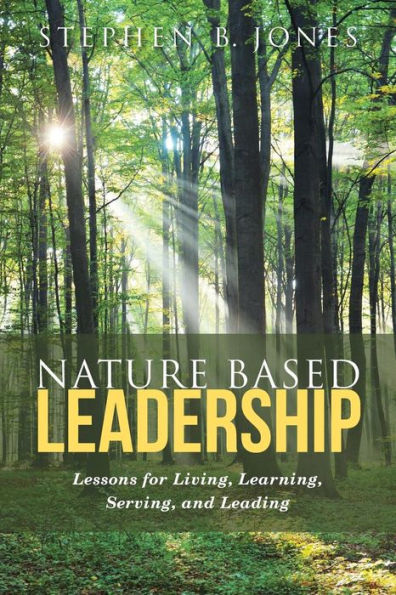Stephen B. Jones offers a way of “being in” the natural world that connects us to the higher goals of insight, purpose, and action. In his book Nature Based Leadership: Living, Learning, Serving, and Leading, published in December 2016, Jones engages all the human portals—mind, heart, body, soul, and spirit—to focus our attention on nature as we experience it on Earth.
Leadership, the nature-based way, serves humanity not only individually but also collectively. Everyone is implicated in learning the lessons that nature can teach or inspire us, even if we aren’t aware of the primacy of nature. For Jones, “All lessons for living, learning, serving and leading are written indelibly in or powerfully inspired by nature.” A potentially transformative book, Nature Based Leadership is about changing minds and embracing a responsible stewardship of Earth.
What is nature-based leadership? At first, you might think, “Well, it’s leadership based on nature,” which it is, of course, but the tautology doesn’t do justice to the complexities that such a leadership entails. This is what Jones achieves in Nature Based Leadership (NBL): A clarification of the incontrovertible relationship between nature and humankind, and its leadership role to ensure that the relationship endures. When you think about it in this way, leadership based on nature seems commonsensical. After all, Earth is the only home we know; we depend on it for our sustenance. However, it is not easy for some people to see nature as a teacher let alone perceive the essential role it plays in our everyday lives. This is where Nature Based Leadership steps into the breach.
The conceptual framework of Nature Based Leadership rests upon the fact and presence of nature: There is no argument that nature is indispensable to humankind, but some could object that we can’t (or don’t) learn lessons from nature, especially lessons of leadership. That nature is cast in a leadership role in Nature Based Leadership could flummox many readers, but Jones lays out his case:
NBL borrows lessons from the ageless evolution of individual species and communities. Far more species have failed than survived over the vast sweep of time. Species often depend upon complex interrelationships within the community (ecosystem) they occupy and, in part, compose. Each species has a plan, hard-wired in DNA. NBL identifies successful strategies and relationships, and extracts those that translate to enterprise applications that leaders can apply.
Whether it is a citizen, government official, NGO, corporation, small business, educator, or religious leader, all can look, see, feel, and act in the service of an “Earth ethic imperative.”
Having established that nature and humankind are bound together, Jones goes further:
Nature-based leadership reminds us nothing is truly distinct from nature, either actually or symbolically. Nature offers limitless lessons and unfathomable inspiration.
To know this to be true, we must remove the filters and see our connectedness with the earth in which we are embedded and allow ourselves to be inspired by ocean sunrises and sunsets; mountain peaks and river valleys; desert storms and fierce prairie winds; forests of birch and maple, juniper and spruce, oak and eucalyptus; wetlands and swamps; sand dunes, waterfalls, rivers, deltas, and bays. When we stop and look and see, we can absorb what surrounds us and feel our absolute dependence on nature. Then, we can act.
How do we move from inspiration to action, from understanding to nature-based leadership? As an applied ecologist and soil scientist who wrote his doctoral dissertation titled “Evaluation of Soil-Site Relationships for Allegheny Hardwoods,” Jones chooses soil as a metaphor to ask, “What quality is your life’s soil? Your enterprise soil?” Explaining the function of soil in nature, Jones writes:
It is a living substrate, an artifact of bedrock, climate, living organisms, topography, and time. It’s a substrate of mineral particles, organic matter, moisture, and air, teeming with roots, fungi, and microbes diverse and abundant. The living components shape the soil; concomitantly, the soil is architect of the living community within it. The relationship is one of complementarity, reciprocity, integration, and absolute interdependence.
What can we learn from the soil that can be applied to leadership?
Metaphorically, the description and function of “leadership soil” can be gleaned from the description and function of soil as found in nature. Just as soil in nature is a living, diverse substrate upon which life depends, so enterprise depends upon leaders who “tap” a diverse soil to provide the substrate needed for success. “Leadership soil,” then, “consists of knowledge, wisdom, experience, ethics, character, motivation, ethos, attitude, environment, teamwork, service, values, spirit, emotion, inspiration, and so much more.” Think of non-profits and corporations or small businesses, educational institutions, churches, and hospitals whose leaders must tap the substrate—the constituent parts—of their organizations. Whether it is earth soil or metaphorical “enterprise” soil, “our roots must find anchorage and sustenance,” in order to find “complementarity, reciprocity, integration, and absolute interdependency.”
As the analogy between earth soil and “leadership soil” shows, leadership the nature-based way adapts lessons inspired by or learned from nature wherein they are integrated into a functioning human environment. This process is not something that can be learned from a management text, a PowerPoint presentation, a seminar, or lecture. Rather, it is by “being in” nature, learning to interpret how nature can teach us and inspire us to act. Thus, Jones offers six lessons that show the scope of nature-inspired relationships, some drawn from personal experience, others from his twelve years as a forestry manager with Union Camp Corporation (a paper and allied products manufacturing firm) and twenty years as a college administrator and CEO of three universities. Undoubtedly, the synergy between the forester and the academic administrator created the just-right blend for the following lessons based on nature:
-
1.
Know what humility and inspiration feel like. The beauty, wonder, and awe of nature can produce these feelings in individuals and leaders. Jones should know, as the pronounced feelings of humility and inspiration were a life-lasting experience when Mt. McKinley rose “18,000 feet from the valley in front of me to its summit.”
2.
Know the seasons of your business or enterprise. Just as the seasons cycle through fall, winter, spring, and summer and preparations must be made to deal with the changes, individuals and leaders must be attuned to the changes in themselves and in their enterprises in order to sense and understand what that change means.
3.
Know your place in the world. The limpet, a marine mollusk, anchors itself to rocks, but in the poem “Security” by Robert Service, it rides the ocean currents, lands on a sandy beach, takes a ride inside a “taxi-crab,” and is devoured. This parable is a warning to individuals and leaders: Know your place and recognize your anchorage. Metaphorically, rocks “come in the form of ethics, character, integrity, fidelity to truth, and all else that constitute the higher road.”
4.
Know and understand your limitations and potential. This lesson is based on Jones’ doctoral research examining “the relationship between key-soil site variables” and environmental potential. The CEO needs to know “both limitations and potential—of people, organizations, and operating environments.”
5.
Know your purpose in life and know what your goals are. “Imagine leading,” Jones writes, “without knowing what motivates and fuels us, what enables and encourages us to add a little wood each year.”
6.
Know, understand, and appreciate the perspectives of others. It is a truism that perspectives differ, sometimes significantly from person to person, but leaders must account for these differences and understand their source. Do any two persons see the forest the same way?
As these lessons illustrate, “nature is a lens through which” Jones views “all that life comprises. Nature nurtures my soul, enriches my mind, commands my heart, fuels my body, and lifts my spirit.” Growing up in Appalachia, he was immersed in the natural world; his father taught him how to be a kid of the outdoors—fishing, hiking, and camping—and his mother and grandmother taught him how to garden. He had mentors along the way, encouraging and assisting him to transfer from Allegany Community College in Cumberland, Maryland, where he was a first-generation forestry student, to SUNY College of Environmental Science and Forestry (ESF) in Syracuse, New York. When he graduated, he was encouraged to apply for a forestry job at the Union Camp Corporation, and after twelve years of “practical work,” he was further advised to redirect his career to graduate school, where he was awarded a fellowship and tuition waiver toward his doctoral study. He never looked back. His mentors at SUNY inspired him to conceive of the concept of nature-based leadership, and, as a student of nature, his own leadership style has transitioned “from primarily objective and empirical, to the subjective and empathic.” This subjective and empathic leadership is obvious when he writes about the weather: “I see magic, power, wonder, beauty, inspiration and awe even in the more subdued weather that graces our lives every day. Weather is one of nature’s threads, perhaps the most palpable and tangible. Those threads weave the essence of the fabric of my life.”
On June 1, 2017, President Donald J. Trump announced that the United States would withdraw from the Paris climate accord, an agreement within the United Nations Framework Convention on Climate Change signed by 195 countries on December 12, 2015. The United States is now one of only three countries that will not be a participant in the Paris Agreement (Syria and Nicaragua are the other two). In 2015, President Barack Obama pledged that the U.S would reduce its emissions of heat-trapping gases by 26 percent to 28 percent below 2005 levels by 2025. To make this pledge stick, President Obama signed executive orders to curb climate change; however, President Trump has signed executive orders to reverse these regulations. It will be, therefore, nearly impossible for the U.S. to adhere to a 26 percent to 28 percent reduction of greenhouse gases by 2025. In fact, the world will most likely reach the 2 degree Celsius mark (3 degrees Fahrenheit) in a matter of years, at which point there is no going back to reversing the anticipated catastrophic results, caused in large measure by human action. The consequences of global warming: Higher global temperatures are being set; Antarctica’s great ice sheets are disintegrating; Arctic sea ice is vanishing; low-lying cites like Miami, New Orleans and New York City, and countries like Bangladesh and Vietnam, are vulnerable to rising sea levels; and severe drought, increased destructive storms, flooding, and widespread food and water shortages are the future of our planet.
As I was reading Nature Based Leadership, I began to think we must address the disbelief about climate change at the emotional level. This is by no means a new thought, but I was inspired to construct the following schematic representation to illuminate the conceptual framework of Nature Based Leadership:
Perception → Awareness → Understanding → Acceptance →
Articulation = Implementation
Then, I began to think: How do you change perceptions so entrenched that people are willing to gamble that climate change is a hoax? Fear, anger, political partisanship, and sacrosanct beliefs may be among the reasons why scientific evidence showing human action as a factor in global warming has not been persuasive. The following passage in Nature Based Leadership sheds light on this vexing problem: “Seeing what lies hidden within deepens our understanding that nature is an intricate web, that we are one with the intimate interdependence not separate from it.”
Seeing as in perception, and changing hearts as in awareness, lead to new awareness and then to understanding wherein acceptance lies. And where acceptance lies there is the great possibility that articulation and implementation follow.
Reviewer’s Note:
In 2015 while Jones was president of the Antioch University New England (AUNE), he announced the creation of Nature Based Leadership Institute (NBLI). When he envisioned NBLI, his aim was to educate students in the way of nature-based leadership to “instill an Earth Ethic (a disciplined self-awareness and conscience) in every business, NGO, organization, and individual.” Today, AUNE is the academic home of the NBLI, whose mission is to “inspire, educate, and develop values-based leaders and leadership committed to applying nature’s lessons to living, learning, leading, and serving.” Linking scholarship with practice through workshops, symposia, short courses, and lectures, NBLI is a learning environment for students who immerse themselves in the lessons of nature to become leaders in the service of social and environmental justice. After Jones left AUNE in June 2016, he formed the Great Blue Heron, where he consults with enterprises to apply the lessons learned from or inspired by nature to achieve success. The three steps to a successful business?
- View your enterprise as an organism within an ecosystem
- Learn to look, see, feel, and act
- Establish a vision
With The Great Blue Heron, Jones puts Nature Based Leadership: Lessons for Living, Learning, Serving, and Leading into action.




